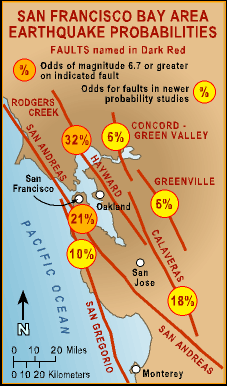|
Because of these high odds for a major quake, the new East Span of the Bay Bridge must be able to withstand some serious shaking. Caltrans (California Department of Transportation) decided that the bridge must be able to absorb the worst earthquake that might hit the Bay Area every 1,500 years. They call that the "Maximum Credible Earthquake" or MCE. Seismically speaking, that means the bridge must withstand an 8.2 magnitude quake (on the Richter scale) on the two faults just a few miles away, the Hayward or the San Andreas. That's 10 times more powerful than the 7.1 magnitude Loma Prieta quake, which broke the Bay Bridge in 1989—and that quake's epicenter was thirty miles away! How will they do it? Try designing the bridge yourself in Engineering for Earthquakes, or learn more about the people and technologies involved in the construction of the bridge in Two Miles & 2,000 Hands! |
